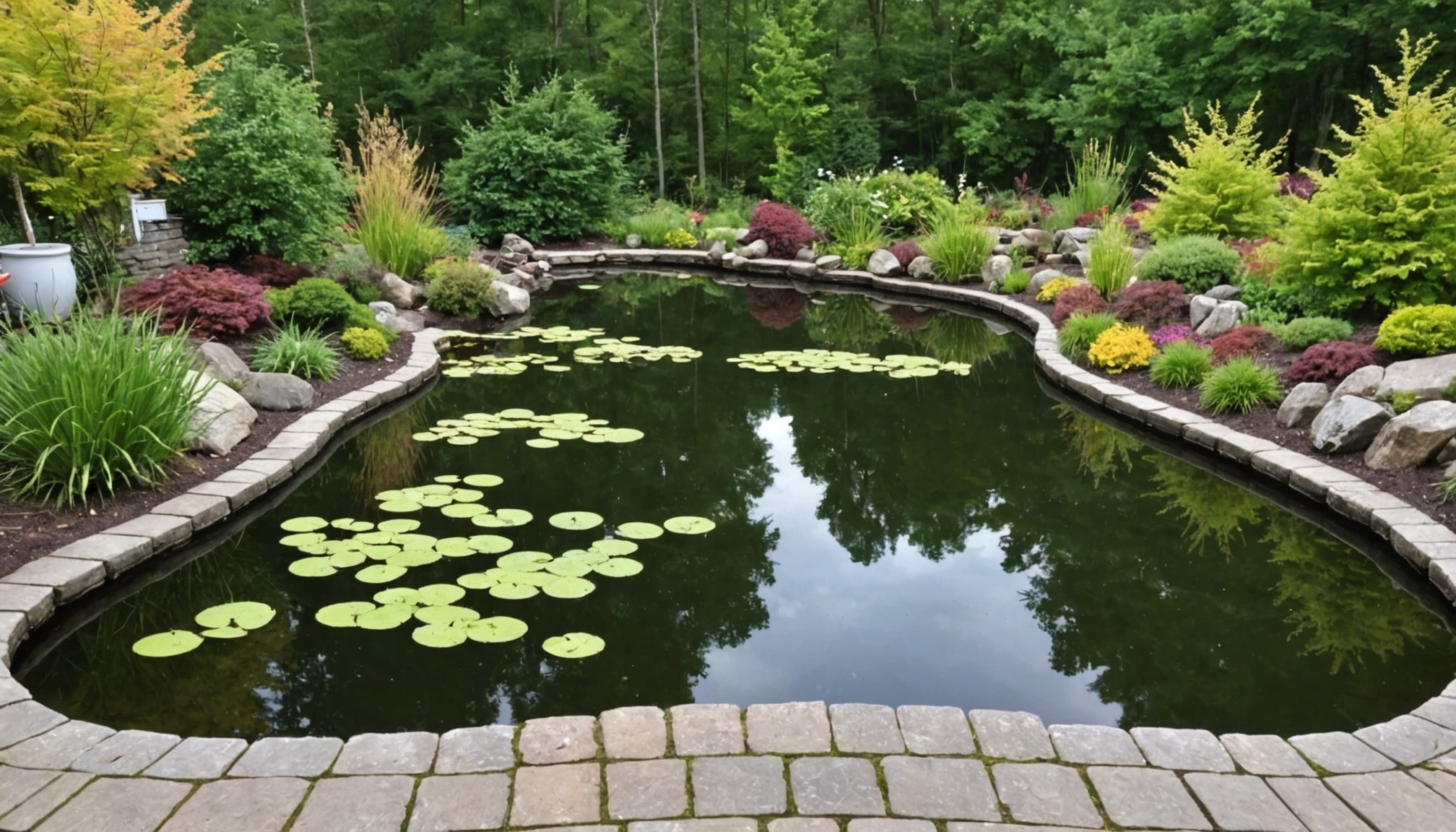Preparation Steps for Winterizing Ponds
When considering winterizing ponds in the Northeast UK climate, timing is crucial. Start preparations early to avoid unexpected cold snaps. As the season turns, gather necessary tools, such as pond nets, brushes, and a pond vacuum. These essentials aid in cleaning and maintenance tasks before winter sets in—removing leaves and debris reduces the risk of decomposition, which can deplete oxygen levels in the water.
Having the right equipment ensures better pond health. A high-quality pond heater or de-icer is vital to maintain a hole in the ice, allowing harmful gases to escape and oxygen to enter. Consider installing a robust filtration system if one isn’t already in place to keep water clear and oxygenated. Additionally, plan for a secure cover to prevent debris accumulation and protect aquatic life from predators.
Topic to read : Mastering the Art of Propagating Rare UK Native Plants: Effective Techniques for Success
Maintenance tasks involve trimming back excess plant material around the pond’s edge and within the water. Doing this reduces organic matter decomposing over winter. Inspect pipework and pumps to ensure they’re functioning optimally, as any defects can exacerbate issues once temperatures drop. By being meticulous and methodical in prep steps, the pond and its inhabitants can thrive through winter’s chill.
Fish Care During the Winter
Caring for pond fish during the winter months is crucial for their health and survival. One essential step is assessing their health before winter settles in. Look out for any signs of illness or stress in your pond fish, like unusual swimming patterns or visible sores. Early detection can ensure timely intervention, providing an opportunity to address these issues before they become more severe in colder conditions.
This might interest you : Ultimate Guide to the Best Mulching Techniques for Weed Control in UK Flower Beds
Maintaining an adequate oxygen supply is fundamental for fish survival. As temperatures drop, ponds are prone to ice formation, which can restrict oxygen exchange. Using a pond de-icer or even an air pump helps keep parts of the water surface ice-free, facilitating adequate gas exchange.
When it comes to feeding practices, remember that fish metabolism slows considerably in cold weather. Pond fish should be given less food, opting for foods that can be easily digested, such as wheat germ pellets, which are suited for low temperatures. Ceasing feeding once water temperatures consistently stay below 10°C can prevent overfeeding, reducing the risk of uneaten food decomposing and affecting water quality.
By following these strategies, the well-being and health of your pond inhabitants can be upheld during the harsh winter months.
Plant Management for Winter Survival
Proper pond plant care is vital to ensure the survival of aquatic plants through harsh Northeast UK winters. Start by identifying hardy plants that can handle the tough climate. Species like water lilies and marsh marigolds are known for their resilience and might require less intensive care.
For more sensitive plants, it’s essential to prepare them for dropping temperatures. Consider bringing them inside, especially if they’re tropical species that won’t survive frost. Alternatively, bury portable containers in the garden soil to insulate the root systems.
To protect all types of plants, whether robust or delicate, proper pruning is crucial. Trim dead or decaying foliage to prevent rot and diseases that could spread. Use this time to cut back growth that could trap ice or snow, reducing the risk of damage.
Employ plant protection methods like floating plant covers or windbreaks. These prevent excessive cold exposure and mitigate the effects of wind chills. Engaging with local community gardening groups can provide insights into tailored protection strategies suited for your specific location. By integrating these prep steps, plant management becomes a proactive task, securing the well-being of your pond’s ecosystem throughout the winter season.
Addressing Common Challenges
Successfully winterizing ponds means facing various winter pond challenges such as ice formation and snow accumulation. Ice can trap toxic gases and limit oxygen flow, threatening aquatic life. To tackle such scenarios, maintaining open water surfaces is crucial. Using pond heaters or de-icers can prevent solid ice layers, allowing necessary gas exchange.
Snow accumulation brings its own set of issues, mainly affecting plants by obstructing light and adding weight. How can this be managed? Regular light sweeping with a broom or soft brush is usually effective. It’s key to do this gently to avoid harming the structural integrity of your pond’s cover.
Fluctuating temperatures are common in the Northeast UK climate, requiring special attention. Rapidly shifting conditions can stress fish and damage plants. A robust filtration system and consistent water quality checks can help buffer against these variations, thus enhancing your pond’s resilience.
Finally, stay vigilant for frost-related damage to equipment like pipes and pumps. Regular inspections and insulation are practical steps for prevention. By anticipating these winter-specific problems and implementing strategies like these, you position your pond to face the colder months with greater assurance and resilience.
Safety Precautions During Winterization
When undertaking safe winterizing practices, it is crucial to ensure both the health of your pond and the safety of those around it. Monitoring ice thickness is a key safety measure; a general rule is that at least 4 inches of clear, solid ice is needed to support the weight of a person. This precaution helps prevent accidents near frozen ponds.
Pond safety measures should also include securing the area with fences or signage to warn of thin ice areas, particularly in the unpredictable Northeast UK climate where conditions can change rapidly.
For preventing pond damage, it is important to handle and store equipment like heaters and pumps properly. Keeping these tools in dry, warm spaces when not in use can extend their longevity and functionality.
Other** best practices** entail regular inspections for any cracks or weaknesses in pond structures that winter conditions may exacerbate. Ensure pathways around the pond are clear and non-slip to avoid accidents. By integrating these preventive strategies, safety becomes an integral part of the winterization process, helping to secure the wellbeing of both the pond environment and human visitors.
Visual Aids and Additional Resources
Exploring visual aids and additional resources can greatly enhance the winterization process for ponds, making each step clearer and more manageable. Diagrams or flowcharts serve as excellent guides to illustrate complex procedures, such as winterizing ponds and maintaining aquatic life throughout the cold months. These visual tools provide an accessible overview, breaking down each task into understandable segments.
Instructional videos are another invaluable resource, allowing pond owners to visually grasp techniques and strategies. These videos often feature experts demonstrating essential prep steps, giving viewers confidence in their methods. Watching others perform tasks like installing a pond heater or safely trimming back excess plant material can make these chores less daunting.
Access to pond maintenance guides provides a wealth of detailed information. These guides cover a wide range of topics, from basic winter care to advanced strategies for addressing unforeseen issues. They are an ideal starting point for individuals seeking comprehensive insights into safeguarding their ponds in the Northeast UK climate.
Lastly, don’t overlook the value of local community expertise. Engaging with nearby gardening or pond enthusiast networks via forums or workshops can offer personalised advice tailored specifically to local conditions, fostering a supportive learning environment.











